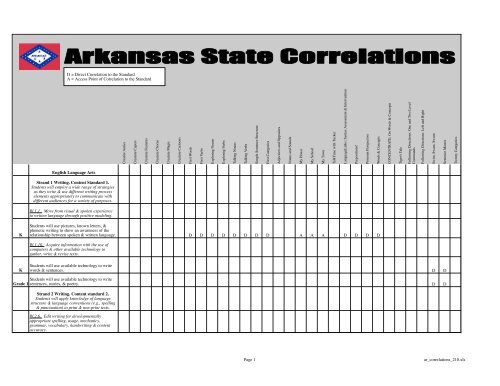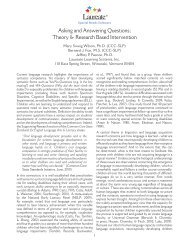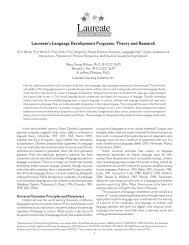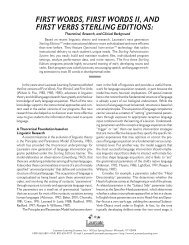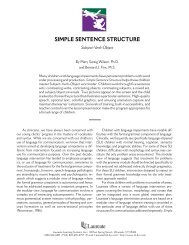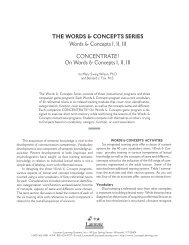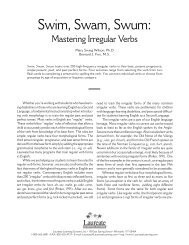English Language Arts Strand 1 Writing. Content Standard 1 ...
English Language Arts Strand 1 Writing. Content Standard 1 ...
English Language Arts Strand 1 Writing. Content Standard 1 ...
Create successful ePaper yourself
Turn your PDF publications into a flip-book with our unique Google optimized e-Paper software.
D = Direct Correlation to the <strong>Standard</strong>A = Access Point of Correlation to the <strong>Standard</strong>Creatire AnticsCreature CapersCreature FeaturesCreature ChorusCreature MagicCreature CartoonsFirst WordsFirst VerbsExploring NounsExploring VerbsTalking NounsTalking VerbsSimple Sentence StructureFirst CategoriesAdjectives and OppositesNouns and SoundsMy HouseMy SchoolMy TownTalkTime with Tucker<strong>Language</strong>Links: Syntax Assessment & InterventionPrepositions!Pronoun PerspectiveWords & ConceptsCONCENTRATE: On Words & ConceptsTiger's TaleFollowing Directions: One and Two LevelCommandsFollowing Directions: Left and RightSwim, Swam, SwumSentence MasterTwenty Categories<strong>English</strong> <strong>Language</strong> <strong>Arts</strong><strong>Strand</strong> 1 <strong>Writing</strong>. <strong>Content</strong> <strong>Standard</strong> 1.Students will employ a wide range of strategiesas they write & use different writing processelements appropriately to communicate withdifferent audiences for a variety of purposes.W.1.1. Move from visual & spoken experienceto written language through positive modeling.KStudents will use pictures, known letters, &phonetic writing to show an awareness of therelationship between spoken & written language. D D D D D D D D A A A D D D DW.1.10. Acquire information with the use ofcomputers & other available technology togather, write & revise texts.KStudents will use available technology to writewords & sentences. D DStudents will use available technology to writeGrade 1 sentences, stories, & poetry. D D<strong>Strand</strong> 2 <strong>Writing</strong>. <strong>Content</strong> standard 2.Students will apply knowledge of languagestructure & language conventions (e.g., spelling& punctuation) to print & non-print texts.W.2.6. Edit writing for developmentallyappropriate spelling, usage, mechanics,grammar, vocabulary, handwriting & contentaccuracy.Page 1ar_correlations_210.xls
D = Direct Correlation to the <strong>Standard</strong>A = Access Point of Correlation to the <strong>Standard</strong>Creatire AnticsCreature CapersCreature FeaturesCreature ChorusCreature MagicCreature CartoonsFirst WordsFirst VerbsExploring NounsExploring VerbsTalking NounsTalking VerbsSimple Sentence StructureFirst CategoriesAdjectives and OppositesNouns and SoundsMy HouseMy SchoolMy TownTalkTime with Tucker<strong>Language</strong>Links: Syntax Assessment & InterventionPrepositions!Pronoun PerspectiveWords & ConceptsCONCENTRATE: On Words & ConceptsTiger's TaleFollowing Directions: One and Two LevelCommandsFollowing Directions: Left and RightSwim, Swam, SwumSentence MasterTwenty CategoriesStudents will use correct spelling for highfrequency words & simple words with regularspelling patterns; use phonetic spelling forGrade 1 unknown words. D DStudents will compose complete sentences inwritten text. A AStudents will use noun, action verbs & adjectivescorrectly in sentences. A A A A A A A A A A A A A D DStudents will write with natural-sounding subjectverbagreement. A AStudents will write with accurate spelling in finalGrade 2 drafts. A A A AStudents will compose a variety of simplesentences in meaningful context.Students will use singular & plural forms ofregular nouns. A A A D D DStudents will write with correct subject-verbagreement. A A A A A AAStudents will use correct irregular verbs.DStudents will write with accurate spelling in finalGrade 3 draft. A DKStudents will compose simple & compoundsentences with elaborated subjects. A DStudents will use singular & plural forms ofregular nouns & adjust verbs for agreement. A A A A D D D<strong>Strand</strong> 3 Listening, Speaking, & Viewing.Contest <strong>Standard</strong>.Students will develop an apply thecommunication skills of speaking, listening &viewing through a variety of informal & formalopportunities.LSV.1.4. Listen to improve reading, oral, &written performance.Students will listen to proficient, fluent models oforal reading using patterned & predictable text. D D D D D D D D D D D D D D D D D D D D D DStudents will listen to proficient, fluent models oforal reading using patterned & predictable text,Grade 1 classic & contemporary works. D D D D D D D D D D D D D D D D D D D D D DPage 2ar_correlations_210.xls
D = Direct Correlation to the <strong>Standard</strong>A = Access Point of Correlation to the <strong>Standard</strong>Creatire AnticsCreature CapersCreature FeaturesCreature ChorusCreature MagicCreature CartoonsFirst WordsFirst VerbsExploring NounsExploring VerbsTalking NounsTalking VerbsSimple Sentence StructureFirst CategoriesAdjectives and OppositesNouns and SoundsMy HouseMy SchoolMy TownTalkTime with Tucker<strong>Language</strong>Links: Syntax Assessment & InterventionPrepositions!Pronoun PerspectiveWords & ConceptsCONCENTRATE: On Words & ConceptsTiger's TaleFollowing Directions: One and Two LevelCommandsFollowing Directions: Left and RightSwim, Swam, SwumSentence MasterTwenty CategoriesKLSV.1.16. Read orally with meaning &expressionStudents will participate in shared reading ofpoems, songs, & stories.Students will read orally from familiar text withfluency (accuracy, expression & attention toGrade 1 punctuation).Students will read orally from familiar text withfluency (accuracy, expression, appropriateGrade 2 phrasing, & attention to punctuation).Students will read orally from familiar text withfluency (accuracy, expression, appropriateGrade 3 phrasing & attention to punctuation).DDDDLSV.1.23. Participate in discussion byalternating the roles of speaker & listener.K Students will actively listen to the speaker. D D D D D A D DGrade 1 Students will actively listen to the speaker. D D D D D A D DGrade 2 Students will actively listen to the speaker. D D D D D A D DGrade 3 Students will listen responsively & reflectively. D D D D D A D D<strong>Strand</strong> 2 Reading: Print Awareness.<strong>Content</strong> <strong>Standard</strong> 1:Student will comprehend, evaluate, & respond toworks of literature & other kinds of writingwhich reflect their own cultures & developingviewpoints as well as those of others.<strong>Content</strong> <strong>Standard</strong> 2:Students will demonstrate a willingness to usereading to continue to learn, to communicate &to solve problems independently.KR.1.1. Demonstrate understanding of therelationship between written & oral language.Students will recognize that print conveysmeaning. D D D D D D D D D D D D D D D DStudents will demonstrate an understanding ofone-to-one correspondence between spoken &written words. D D D D D D D D D D D D D D D DPage 4ar_correlations_210.xls
D = Direct Correlation to the <strong>Standard</strong>A = Access Point of Correlation to the <strong>Standard</strong>Creatire AnticsCreature CapersCreature FeaturesCreature ChorusCreature MagicCreature CartoonsFirst WordsFirst VerbsExploring NounsExploring VerbsTalking NounsTalking VerbsSimple Sentence StructureFirst CategoriesAdjectives and OppositesNouns and SoundsMy HouseMy SchoolMy TownTalkTime with Tucker<strong>Language</strong>Links: Syntax Assessment & InterventionPrepositions!Pronoun PerspectiveWords & ConceptsCONCENTRATE: On Words & ConceptsTiger's TaleFollowing Directions: One and Two LevelCommandsFollowing Directions: Left and RightSwim, Swam, SwumSentence MasterTwenty CategoriesStudents will demonstrate an understanding thatspoken words are represented by letters written inspecific sequences. D D D D D D D D D D D D D D D D DStudents will use their knowledge of oralGrade 1 language (syntax, semantics) to read text. D D D D D D D D D D D D D D D D D D DKR.1.2. Demonstrate & use concepts of print,such as directionality, spacing, punctuation &configuration in developmentally appropriateways.Students will demonstrate an understanding thatprint moves left-to-right across the page & top-tobottom.Students will distinguish between individualGrade 1 letters & printed words.KStudents will recognize that there are correctspelling for words. D D<strong>Strand</strong> 2 Reading: PhonologicalAwareness/Decoding/Vocabulary<strong>Content</strong> <strong>Standard</strong> 1:Student will comprehend, evaluate, & respond toworks of literature & other kinds of writingwhich reflect their own cultures & developingviewpoints as well as those of others.<strong>Content</strong> <strong>Standard</strong> 2:Students will demonstrate a willingness to usereading to continue to learn, to communicate &to solve problems independently.R.1.5. Use major cueing systems, such asphonetic, syntactic & semantic to decode &construct meaning.Students will apply some letter-soundcorrespondence to begin to read.Students will know that written words areGrade 1 composed of letter that represent sounds. D DStudents will use knowledge of common lettersound correspondence, including soundsrepresented by single letters (consonant & vowel)consonant blends, consonant digraphs, voweldigraphs, diphthongs, r-controlled vowels &common spelling patterns to decode &comprehend text. A A A A D D D D DADPage 5ar_correlations_210.xls
D = Direct Correlation to the <strong>Standard</strong>A = Access Point of Correlation to the <strong>Standard</strong>Creatire AnticsCreature CapersCreature FeaturesCreature ChorusCreature MagicCreature CartoonsFirst WordsFirst VerbsExploring NounsExploring VerbsTalking NounsTalking VerbsSimple Sentence StructureFirst CategoriesAdjectives and OppositesNouns and SoundsMy HouseMy SchoolMy TownTalkTime with Tucker<strong>Language</strong>Links: Syntax Assessment & InterventionPrepositions!Pronoun PerspectiveWords & ConceptsCONCENTRATE: On Words & ConceptsTiger's TaleFollowing Directions: One and Two LevelCommandsFollowing Directions: Left and RightSwim, Swam, SwumSentence MasterTwenty CategoriesStudents will use knowledge of word structuresuch as root words, inflectional endings,compound words & contractions to decode &comprehend text. A A A A D D D DStudents will recognize a core (approximately 40)of high frequency words. D D D D D D D D D D D D D DStudents will integrate context clues, pictureclues, knowledge of sentence structure &graphophonics to decode & comprehend text. D D D D D D D D A A A D D D D D D D DStudents will identify unknown words incontinuous text by reading, cross-checking,D searching for additional cues, etc.DStudents will use knowledge of common lettersound correspondence, including soundsrepresented by single letters (consonant & vowel)consonant blends, consonant digraphs, consonantvariants (hard c, soft c), vowel digraphs,diphthongs, r-controlled vowels & commonGrade 2 spelling patterns to decode & comprehend text. A A A A D D D DStudents will use knowledge of word structuresuch as root words, inflectional endings,compound words & contractions & simpleprefixes & suffixes to decode & comprehend text. A A A A D D D DStudents will recognize a large core of highfrequency words. D D D D D D D D D D D D D DStudents will integrate context clues, pictureclues, knowledge of sentence structure &graphophonics to decode & comprehend text. D D D D D D D D A A A D D D D D D D DStudent will use knowledge of word structure,such as root words, inflectional endings,compound words, contractions & more complexprefixes & suffixes, to decode & comprehendGrade 3 text. A A A A D D D DStudents will recognize a large core of highfrequency words. D D D D D D D D D D D D D DStudents will integrate context clues, pictureclues, knowledge of sentence structure &graphophonics to decode & comprehend text. D D D D D D D D A A A D D D D D D D DR.1.6. Expand vocabulary through reading.Students will use the vocabulary & "booklanguage" learned from reading stories &informational texts in their own speaking,Grade 1 reading, & writing.DPage 6ar_correlations_210.xls
D = Direct Correlation to the <strong>Standard</strong>A = Access Point of Correlation to the <strong>Standard</strong>Creatire AnticsCreature CapersCreature FeaturesCreature ChorusCreature MagicCreature CartoonsFirst WordsFirst VerbsExploring NounsExploring VerbsStudents will incorporate words learned fromreading narrative text & studying content areasinto their own reading, speaking & writingGrade 2 activities. D DStudents will incorporate words learned fromreading narrative text & studying content areasinto their own reading, speaking & writingGrade 3 activities. D DTalking NounsTalking VerbsSimple Sentence StructureFirst CategoriesAdjectives and OppositesNouns and SoundsMy HouseMy SchoolMy TownTalkTime with Tucker<strong>Language</strong>Links: Syntax Assessment & InterventionPrepositions!Pronoun PerspectiveWords & ConceptsCONCENTRATE: On Words & ConceptsTiger's TaleFollowing Directions: One and Two LevelCommandsFollowing Directions: Left and RightSwim, Swam, SwumSentence MasterTwenty CategoriesK<strong>Strand</strong> 2 Reading: Comprehension<strong>Content</strong> <strong>Standard</strong> 1:Student will comprehend, evaluate, & respond toworks of literature & other kinds of writingwhich reflect their own cultures & developingviewpoints as well as those of others.<strong>Content</strong> <strong>Standard</strong> 2:Students will demonstrate a willingness to usereading to continue to learn, to communicate &to solve problems independently.R.1.7. Understand the goal of reading is toconstruct meaning.Students will begin to build connections betweentext that is read & own ideas, experiences &knowledge. D D D D D DStudents will monitor their own comprehension& when comprehension breaks down, useappropriate fix-up strategies which may include:reread, use illustrations to adjust or confirmmeaning, cross check, predict & confirm formGrade 1 mental pictures from text description. D D D D D D D D DStudents will monitor their own comprehension& when comprehension breaks down, useappropriate fix-up strategies which may include:read on/read back predict/confirm, form mentalGrade 2 pictures, adjust reading rate. D D D D D D D D DStudents will monitor their own comprehension& when comprehension breaks down, useappropriate fix-up strategies which may include:self-correct, reread, read on, self-question, adjustreading rate, search for clues, summarize, formGrade 3 mental pictures, read a portion aloud. D D D D D D D D DR.1.10. Use relationship between words &sentences, sentences & paragraphs, ¶graphs & whole pieces to understand text.Page 7ar_correlations_210.xls
D = Direct Correlation to the <strong>Standard</strong>A = Access Point of Correlation to the <strong>Standard</strong>KCreatire AnticsCreature CapersCreature FeaturesCreature ChorusCreature MagicCreature CartoonsFirst WordsFirst VerbsStudents will recognize a group of words as asentence that expresses a complete thought. D D D D D DExploring NounsExploring VerbsStudents will use the context of the sentence toGrade 1 decode unknown words. D DStudents will use the context of the sentence toGrade 2 decode unknown words. D DStudents will use the context of the sentence toGrade 3 decode unknown words. D DKR.1.11. Use prior knowledge to extend readingability & comprehension.Students will use their own knowledge &experiences to anticipate meaning & make senseof text read to them. D DStudents will build connections between text thatis read or heard & their own experiences &Grade 1 knowledge to make sense of text. D D DStudents will build connections between text thatis read or heard & their own knowledge &Grade 2 experiences to make sense of text. D D DStudents will use their own ideas, experiences &knowledge of topic & text structures to anticipateGrade 3 meaning & make sense of text. D D DTalking NounsTalking VerbsSimple Sentence StructureFirst CategoriesAdjectives and OppositesNouns and SoundsMy HouseMy SchoolMy TownTalkTime with Tucker<strong>Language</strong>Links: Syntax Assessment & InterventionPrepositions!Pronoun PerspectiveWords & ConceptsCONCENTRATE: On Words & ConceptsTiger's TaleFollowing Directions: One and Two LevelCommandsFollowing Directions: Left and RightSwim, Swam, SwumSentence MasterTwenty Categories<strong>Strand</strong> 2 Reading: Fluency<strong>Content</strong> <strong>Standard</strong> 1:Student will comprehend, evaluate, & respond toworks of literature & other kinds of writingwhich reflect their own cultures & developingviewpoints as well as those of others.<strong>Content</strong> <strong>Standard</strong> 2:Students will demonstrate a willingness to usereading to continue to learn, to communicate &to solve problems independently.Students will self-select materials on independentreading level based on personal interests &knowledge of authors & different types of texts.R.2.3. Demonstrate fluency & comprehension inboth silent & oral reading.K Students will participate in shared reading. DStudents will read familiar text fluently.DPage 8ar_correlations_210.xls
D = Direct Correlation to the <strong>Standard</strong>A = Access Point of Correlation to the <strong>Standard</strong>Creatire AnticsCreature CapersCreature FeaturesCreature ChorusCreature MagicCreature CartoonsFirst WordsFirst VerbsExploring NounsExploring VerbsStudent will read grade-level materials with anaverage of only two-three word difficulties perGrade 1 100 words. DStudents will read orally from familiar text withfluency (accuracy, expression, appropriatephrasing & attention to punctuation).DStudents will read orally from familiar text withfluency (accuracy, expression, appropriateGrade 2 phrasing & attention to punctuation).Students will read orally from familiar text withfluency (accuracy, expression, appropriateGrade 3 phrasing & attention to punctuation).<strong>Strand</strong> 2 Reading: Literary Response<strong>Content</strong> <strong>Standard</strong> 1:Student will comprehend, evaluate, & respond toworks of literature & other kinds of writingwhich reflect their own cultures & developingviewpoints as well as those of others.<strong>Content</strong> <strong>Standard</strong> 2:Students will demonstrate a willingness to usereading to continue to learn, to communicate &to solve problems independently.R.2.5. Respond to reading in a variety of ways(e.g. writing, retelling art, drama).Talking NounsTalking VerbsSimple Sentence StructureFirst CategoriesAdjectives and OppositesNouns and SoundsMy HouseMy SchoolMy TownTalkTime with Tucker<strong>Language</strong>Links: Syntax Assessment & InterventionPrepositions!Pronoun PerspectiveWords & ConceptsCONCENTRATE: On Words & ConceptsTiger's TaleFollowing Directions: One and Two LevelCommandsFollowing Directions: Left and RightSwim, Swam, SwumSentence MasterDDTwenty CategoriesKStudents will respond through talk, movement,music, art, drama & writing to a variety of stories& poems in ways that reflect understanding. D D D D D D D D D DStudents will relate the life experiences ofcharacters in stories to their own experiences.DStudents will respond through talk, movement,music, art, drama & writing to a variety of storiesGrade 1 & poems in ways that reflect understanding. D D D D D D D D D DStudents will relate the life experiences,language, customs & cultures of characters in textto their own experiences.DStudents will relate the life experiences,language, customs & cultures of characters in textGrade 2 to their own experiences.Students will relate the life experiences,language, customs & culture of characters in textGrade 3 to their own experiences.DDPage 9ar_correlations_210.xls
D = Direct Correlation to the <strong>Standard</strong>A = Access Point of Correlation to the <strong>Standard</strong>Creatire AnticsCreature CapersCreature FeaturesCreature ChorusCreature MagicCreature CartoonsFirst WordsFirst VerbsExploring NounsExploring VerbsTalking NounsTalking VerbsSimple Sentence StructureFirst CategoriesAdjectives and OppositesNouns and SoundsMy HouseMy SchoolMy TownTalkTime with Tucker<strong>Language</strong>Links: Syntax Assessment & InterventionPrepositions!Pronoun PerspectiveWords & ConceptsCONCENTRATE: On Words & ConceptsTiger's TaleFollowing Directions: One and Two LevelCommandsFollowing Directions: Left and RightSwim, Swam, SwumSentence MasterTwenty CategoriesR.1.22. Use technological aides (e.g. data base,spreadsheet, desktop publishing) to supportgrowth in reading.KStudents will use available technologies topractice reading. D D D D D D D D D DStudents will use available technologies toGrade 1 practice reading. D D D D D D D D D DR.2.6. Use reading to enhance writing.KStudents will apply concepts of print to theirwriting. D DStudents will apply concepts of print to theirGrade 1 writing. D DStudents will apply new vocabulary & conceptsGrade 2 into their writing.Students will apply new vocabulary & conceptsGrade 3 from reading to writing.DDPage 10ar_correlations_210.xls


